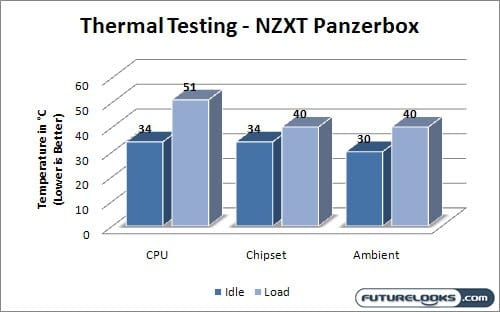The New Hotness or Just Hot?
Testing for the NZXT Panzerbox basically consisted of two areas of focus; thermals and noise. As you can probably guess, we started with thermal testing. For this we used the program OCCT to both simultaneously push the system to 100% load and measure the temperatures while under load. The system was left idling from 30 minutes to let temperatures and activity stabilize. Once that was over, temperatures were taken and OCCT was started to push the CPU to 100% and place stress on the RAM and video card. After 60 minutes of this, the temperatures were taken again.

The results were a little high compared to some other case/cooler combos we’ve reviewed in the past. The TT SpinQ cooler we used is as yet untested in our suite of benchmarks. Luckily a quick browse around the internet shows only one of two other sites who reviewed this case is actually doing thermal tests (WTF guys?), but those that did showed numbers very similar to what I’m getting with similar hardware.
The performance gap between idle and load on the CPU is a little worrisome at 44%, but it’s also the hottest component. The other two points of focus are well within reason, and all three scores should give enough breathing room for a decent overclock.
Noise Levels
When it came to noise testing, our methods were much more simple. Noise testing was performed using a DB Meter, first measuring the ambient noise in the room with everything silenced and turned off. The meter was then pointed at the case in three different locations. The directional microphone was aimed on centre, and was perched on a tripod 6 inches away from each target. The room was brought to a silence, and the DB Meter was given a minute to stabilize. This was repeated for each test location.
- Ambient Noise: 45.9 dBA
- Front: 55.6 dBA
- Left Panel: 54.7 dBA
- Right Panel: 56.1 dBA
Now these results are a fair degree higher then any other case I’ve reviewed, and it showed when I was using the system I built with this case. The noise generated by this was quite pronounced in my now quiet office, and when I powered my very large and power main rig back up this system still managed to drown that out. This may be lost in the din and noise found at most LAN parties, but in the home it’s definitely noticeable.
The 190mm fans are 3-pin models, and quite adjustable, but you’ll still need a decent fan controller of some type. I wouldn’t recommend hooking up the 190mm fans to motherboard headers, as that size of fan may not get enough power from the mobo and burn out the fan header. So I think it’s easy to say that the Panzerbox takes care of business when it comes to cooling, but it really doesn’t do so quietly.
Final Thoughts and Conclusion
The NZXT Panzerbox delivers on what it promises. The case is nice and compact, and very light. It’s essentially the perfect case for a schlep to your local LAN event, and across the country to meet people you only know online. It lacks any significant compromises, allowing you to install a full complement of hardware to ensure your victory over most in whatever online battlefield you call home.

The case does also lack a couple very beneficial features. The first is decent cable management. Some extra accessories to help with winding all that cable through the diminutive enclosure would have been greatly appreciated. Also the fans on the Panzerbox are rather loud, something that is actually rather surprising considering the larger the fan the less noise it is supposed to make. A fan controller is almost a required purchase should you want to run this at home. Since the fans are an odd 190mm width, you also just can’t go and replace them with something quieter.
In the end, I still like this case. It does have some short comings but it’s also very good at the one thing it one bought for; portability without compromise. I have access to a large number of cases, and I’ve chosen this one to be the enclosure that houses my components for this year’s Fragapalooza event. The price is also right, with the Panzerbox being able to be found for $120 USD online. Compared to the price of other aluminum cases using this thickness of aluminum, that’s a good deal. That plus the innovative design makes the Panzerbox a great case from the gamer on the go.
Pros
- Good cooling performance
- Unique design, excellent focus on portability
- Excellent water cooling support
- Easy to install and setup
- Good price
Cons
- Cable management a bit of a mess
- Loud fans, can’t be swapped out
- Placement of one hard drive rack blocks airflow
Overall Rating: 8.5 / 10.0

Loved This Review? Hated This Review? Sound Off Here!
